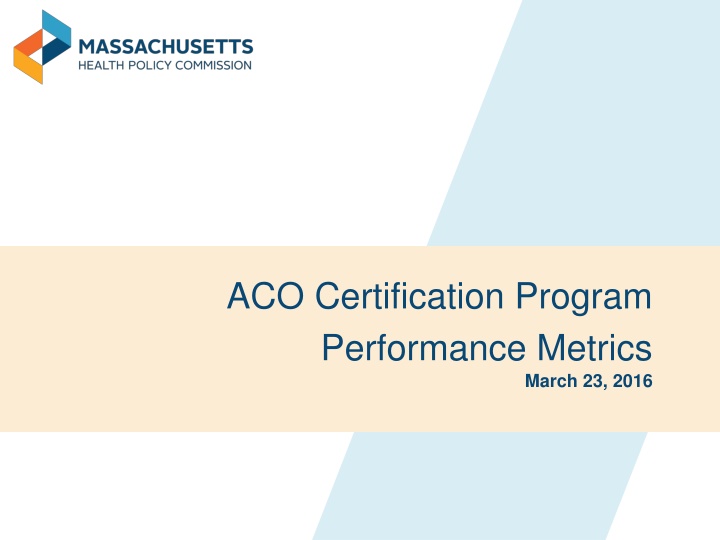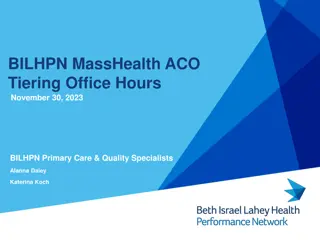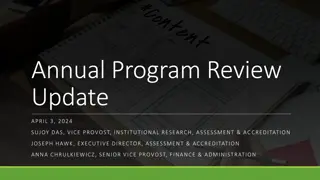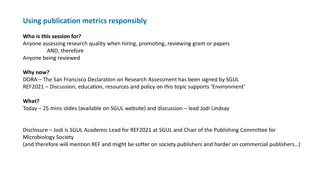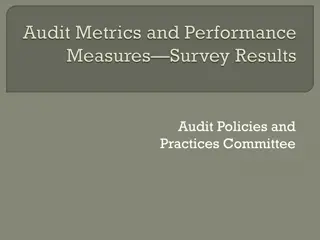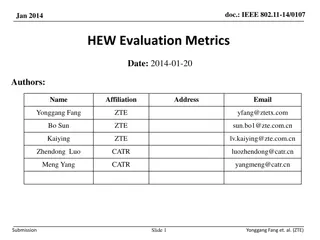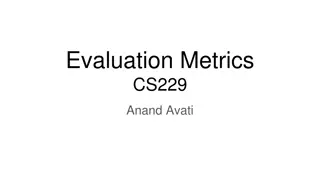ACO Certification Program Performance Metrics
This overview examines the ACO Certification Program's performance metrics, goals, structure, and proposed design. It covers the vision of Accountable Care, the arc of the certification program, key areas of focus, and the prerequisites for participation. The content outlines the need for data collection, patient engagement, alignment with payers, evidence on ACO capabilities, and standards for enabling payment reform. It also discusses the certification standards, governance structure, quality measures, and the importance of cross-continuum care and patient-centered approaches.
Download Presentation

Please find below an Image/Link to download the presentation.
The content on the website is provided AS IS for your information and personal use only. It may not be sold, licensed, or shared on other websites without obtaining consent from the author.If you encounter any issues during the download, it is possible that the publisher has removed the file from their server.
You are allowed to download the files provided on this website for personal or commercial use, subject to the condition that they are used lawfully. All files are the property of their respective owners.
The content on the website is provided AS IS for your information and personal use only. It may not be sold, licensed, or shared on other websites without obtaining consent from the author.
E N D
Presentation Transcript
ACO Certification Program Performance Metrics March 23, 2016
ACO certification program goals Vision of Accountable Care A health care system that efficiently delivers well coordinated, patient-centered, high- quality health care, integrates behavioral and physical health, and produces optimal health outcomes and health status through the support of alternative payment. Create a roadmap for providers to work toward care delivery transformation balancing the establishment of standards with room and assistance for innovation 1 Establish a commonframework for data collection, information gathering, evaluation and dissemination of best practices to promote transparency for future learning 2 Develop standards that align with payers own principles for accountable care to further link accountability and enhance administrative simplification 3 Assure patient engagement and protection, especially for vulnerable populations 4 2
Arc of the ACO certification program Multiple ACO programs in the market Medicare ACOs (i.e., MSSP, Pioneer, Next Gen) Commercial programs (e.g., BCBSMA s AQC) Medicaid ACOs General lack of evidence on the relationship between ACO capabilities and outcomes Current market Build baseline knowledge and transparency around current ACO capabilities Articulate standards for ACOs to enable payment reform Facilitate learning as a program and across ACOs First year certification focus Develop evidence on what advances transparency and efficiency in the market Move from structural requirements to outcomes and performance requirements Vision 3
Overall ACO program structure I II III Performance on Total Medical Expense (TME) (2017 onward) Performance on Quality Measures (2017 onward) Certification Standards (2016) - - Governance structure Population health management Cross continuum care Patient-centered primary care Needs and preferences of patient population Community-based health programs Quality and financial analytics Patient experience High quality care Shared savings/losses HIT - - - - - Prevention and wellness Chronic care Behavioral health Care coordination Patient and family experience Efficiency (e.g., hospital- wide readmissions) Overuse (e.g., imaging, antibiotic use) - - - - TME data (from CHIA) - - - - - - - - ACO Technical Assistance 4
Proposed ACO certification program design Pre-requisites Participation in at least one quality-based risk contract Risk-bearing provider organizations (RBPO) certificate, if applicable Any required Material Change Notices (MCNs) filed Anti-trust laws Patient protection 5 pre-reqs. Attestation only 1 Assessment Criteria 5 criteria Sample documents, narrative descriptions Patient-centered, accountable governance structure Population health management programs Cross continuum care: coordination with BH, hospital, specialist, and long-term care services 2 Required Supplemental Information Supports patient-centered primary care Assesses needs and preferences of ACO patient population Develops community-based health programs Provides palliative care Performs quality, financial analytics and shares with providers Evaluates and seeks to improve patient experiences of care Provides high quality care Distributes shared savings or deficit in a transparent manner Commits to advanced health information technology (HIT) integration and adoption 9 criteria Narrative or data Not evaluated by HPC but must respond 5
MassHealth measure set - DRAFT under development Measure Patient Experience Survey (in development) Prevention & Wellness Pediatrics Measure Chronic Disease Management Controlling high blood pressure (CBP) PQI-5: COPD PQI-8: Congestive Heart Failure Admission Rate Medication Management for People with Asthma (MMA) Comprehensive diabetes care: A1c poor control (CDC) Comprehensive diabetes care: High blood pressure control (CDC) Behavioral Health / Substance Abuse Well child visits in first 15 months of life (W15) Well child visits 3-6 yrs (W34) Adolescent Adolescent well-care visit (AWC) Screening for clinical depression and follow-up plan: Ages 12-17 Weight Assessment and Counseling for Nutrition and Physical Activity for Children/Adolescents (WCC) Screening for clinical depression and follow-up plan: Age 18+ Maternity Depression remission at 12 months Prenatal and postpartum care Initiation and Engagement of AOD Treatment (IET) PC-01 Elective Delivery Follow-Up After Hospitalization for Mental Illness (FUH) Oral Use of Multiple Concurrent Antipsychotics in Children and Adolescents (APC) Oral Evaluation, Dental Services Adult (emphasis on SDH) Follow-up care for children prescribed ADHD medication Tobacco use assess and cessation intervention Long Term Services and Supports Patients 18 and older with documentation of a functional outcome assessment and a care plan Service/care plans address participants' assessed needs (including health and safety risk factors) either by the provision of waiver services or through other means Adult BMI Assessment (ABA) Avoidable Utilization % reduction in avoidable inpatient admissions % reduction in hospital all-cause readmissions 6
CMS/AHIP ACO core measure set released 2/6/16 Utilization and Cost/Overuse - Use of imaging studies for low back pain Cardiovascular Care - Controlling high blood pressure - Persistent beta blocker treatment after heart attack - Ischemic vascular disease: use of aspirin or another antithrombotic Pulmonary - Medication management for people with asthma - Avoidance of antibiotic treatment in adults with acute bronchitis Diabetes - Comprehensive diabetes care: HbA1c poor control (>9.0%) - Comprehensive diabetes care: eye exam - Comprehensive diabetes care: hemoglobin A1c (HbA1c) testing - Comprehensive diabetes care: foot exam - Comprehensive diabetes care: medical attention for nephropathy Behavioral Health - Depression remission at 12 months - Depression remission at 12 months progress toward remission Care Coordination / Patient Safety - Medication reconciliation Patient Experience - CG CAHPS - Getting timely care, appointments, and information - How well your doctors communicate - Patients rating of doctor - Access to specialists - Health promotion and education - Shared decision making - Health status/functional status - Stewardship of patient resources Prevention and Wellness - Cervical cancer screening - Non-recommended cervical cancer screening in adolescent females - Breast cancer screening - Colorectal cancer screening - Preventive care screening: tobacco use: screening and cessation - Preventive care and screening: body mass index (BMI) screening and follow-up 7 * Overlap with MassHealth measures indicated in red
Proposed HPC ACO measure set Ambulatory care- sensitive admissions condition-specific measures1 CMS Hospital-Wide Readmissions2 CMS/AHIP ACO core measure set (previous slide) HPC ACO measure set Pediatric measures (next slide) 1AHRQ s Prevention Quality Indicators (PQI); data source: CHIA/Hospital Discharge Database (HDD) 2 Hospital-Wide-All-Cause Unplanned Readmission (Yale/CMS); NQF#1789; data source: CHIA/Hospital Discharge Database (HDD) 8
Proposed pediatric measures for HPC ACO measure set Well-child visits in the third, fourth, fifth and sixth years of life Weight assessment and counseling for nutrition and physical activity Well-child visits in the first 15 months of life Adolescent well- care visits Use of multiple concurrent antipsychotics in children and adolescents Screening for clinical depression and follow-up (ages 12-17) Appropriate testing of children with pharyngitis Follow-up care for children prescribed ADHD medication CG/CAHPS: Child - Access to care - Communication quality - Care coordination - Integration of care Childhood immunization status MassHealth and BCBSMA measures MassHealth measures BCBSMA measures 9
ACO quality measurement process timeline Activity 2016 2017 2018 Collaborate with MassHealth & CHIA to collect and report on patient experience data. Exploring options on other data. Patient experience survey procurement (June) Patient experience survey fielded (Spring) HPC will measure ACO quality as part of recertification 10
